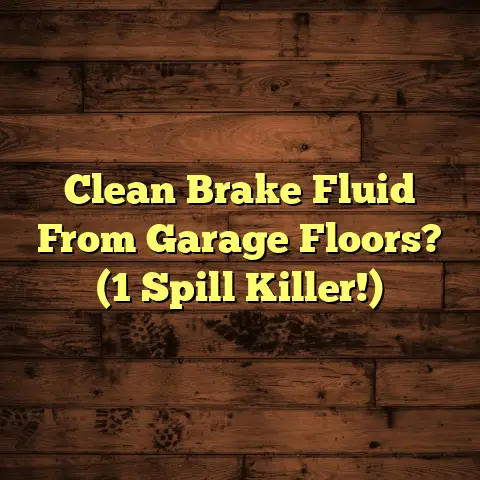Best Tile Disinfectant? (3 Germs You Must Kill!)
Imagine this: You walk into your home, sunlight dances on your tile floors, and everything looks sparkling clean.
But what if I told you that beneath that shine, a hidden world of germs is throwing a party?
Yeah, not so appealing, right?
As a flooring contractor with years of experience, I’ve seen it all – and I’m here to help you win the war against those microscopic invaders!
In this article, we’re diving deep into the world of tile disinfectants.
We’ll uncover the three nasty germs you absolutely need to eliminate and find the best products to do it.
Ready to make your home truly clean?
Let’s get started!
Section 1: Understanding Tile Surfaces
and Their Vulnerabilities
First things first, let’s talk tile.
We’re not just talking about your standard bathroom squares here.
There’s a whole world of options:
-
Ceramic: Your classic, budget-friendly choice, great for general use.
-
Porcelain: Denser and more durable than ceramic, perfect for high-traffic areas.
-
Natural Stone: Think granite, marble, slate – beautiful, but also more porous.
Now, here’s the thing: all these surfaces, especially in kitchens and bathrooms, are prime real estate for germs.
Why?
Moisture!
Those damp environments are like five-star hotels for bacteria and viruses.
Plus, think about all the foot traffic, spills, and general daily life that happens on your floors.
It’s a recipe for germ city!
That’s why regular cleaning and, more importantly, disinfecting is crucial.
We’re not just talking about making things look clean; we’re talking about protecting your health.
Section 2: The Top 3 Germs
Hiding on Your Tiles
Okay, let’s get down to the nitty-gritty.
These are the three big baddies you need to be aware of:
Germ #1: E. coli
E. coli. You’ve probably heard of it.
It’s a type of bacteria that can come from various sources, like contaminated food, water, or even just poor hygiene.
How does it end up on your tiles?
Think about raw meat preparation in the kitchen, or even just tracking in dirt from outside.
E. coli can cause some nasty symptoms, including diarrhea, stomach cramps, and vomiting.
In severe cases, it can even lead to kidney failure. Not fun!
Germ #2: Salmonella
Salmonella is another foodborne illness culprit that can easily find its way onto your tile surfaces.
Think about handling raw chicken or eggs in the kitchen.
Even if you’re careful, tiny droplets can splatter and land on your floors.
Salmonella can cause fever, diarrhea, and abdominal cramps.
It’s especially dangerous for young children, the elderly, and people with weakened immune systems.
Germ #3: Staphylococcus aureus (Staph)
Staph is a common bacteria that lives on our skin and in our noses.
Usually, it’s harmless.
But, if it gets into a cut or wound, it can cause an infection.
And guess what?
It can also survive on surfaces like tile for extended periods.
Staph infections can range from minor skin problems like boils to more serious infections like pneumonia and bloodstream infections.
MRSA (Methicillin-resistant Staphylococcus aureus) is a particularly resistant strain of Staph that can be difficult to treat.
Section 3: The Importance
of Disinfecting Tiles
Now, let’s clear up a common misconception:
Cleaning and disinfecting are not the same thing!
Cleaning simply removes dirt and grime from a surface.
Think of it like sweeping up crumbs.
Disinfecting, on the other hand, kills germs and bacteria.
It’s like using a flamethrower on those unwanted party guests!
Simply cleaning with soap and water can remove some germs, but it won’t eliminate them entirely.
You need a disinfectant to truly kill the harmful bacteria and viruses that can make you sick.
I know this from experience.
I’ve seen countless homes where people thought their floors were clean, but a simple swab test revealed a shocking amount of bacteria.
According to the EPA, registered disinfectants kill 99.9% of germs.
That’s a huge difference compared to just cleaning!
Section 4: Criteria for Choosing
the Best Tile Disinfectant
Alright, so you’re convinced that you need to disinfect your tiles.
Great!
But with so many products on the market, how do you choose the right one?
Here are some essential features to look for:
EPA Approval and Safety Certifications: This is a big one.
Look for products that are registered with the EPA and have been tested for safety and efficacy.Broad-Spectrum Efficacy: Make sure the disinfectant is effective against a wide range of bacteria and viruses, including E.
coli, Salmonella, and Staph.Non-Toxicity: You don’t want to replace germs with harmful chemicals.
Look for disinfectants that are safe for use around children and pets.-
Ease of Application: Choose a product that’s easy to use and doesn’t require a lot of special equipment or training.
Surface Compatibility: Some disinfectants can damage certain types of tile.
Make sure the product is safe for use on your specific type of tile.Dwell Time: This is the amount of time the disinfectant needs to stay wet on the surface to effectively kill germs.
Pay attention to the dwell time listed on the product label.
Section 5: Review of the Best
Tile Disinfectants
Okay, let’s get to the good stuff!
Based on my experience and research, here are three tile disinfectants that I recommend:
Product A: Lysol Disinfectant
Concentrate
-
Key Ingredients: Alkyl dimethyl benzyl ammonium chloride.
-
Effectiveness: Kills 99.9% of viruses and bacteria, including E. coli, Salmonella, and Staph.
-
User Reviews: Generally positive, with users praising its effectiveness and ease of use.
-
Pricing: Affordable and widely available.
-
Pros: Broad-spectrum efficacy, easy to find, well-known brand.
-
Cons: Can have a strong odor, may require dilution.
Product B: Clorox Disinfecting
Wipes
-
Key Ingredients: Isopropyl alcohol, alkyl dimethyl benzyl ammonium chloride.
-
Effectiveness: Kills 99.9% of germs, including E. coli, Salmonella, and Staph.
-
User Reviews: Very popular for their convenience and ease of use.
-
Pricing: Slightly more expensive than Lysol concentrate.
-
Pros: Convenient, pre-moistened wipes, good for quick cleanups.
-
Cons: Can be wasteful, not as cost-effective for large areas.
Product C: Benefect Decon 30 Disinfectant
-
Key Ingredients: Thymol (derived from thyme oil).
-
Effectiveness: Kills 99.99% of bacteria, fungi, and viruses, including E. coli, Salmonella, and Staph.
-
User Reviews: Highly rated for its non-toxic formula and pleasant scent.
-
Pricing: More expensive than Lysol or Clorox.
-
Pros: Plant-based, non-toxic, safe for use around children and pets.
-
Cons: Higher price point, may not be as widely available.
Comparative Analysis:
My Recommendation:
For overall value and effectiveness, Lysol Disinfectant Concentrate is a great choice.
If you prioritize convenience, Clorox Disinfecting Wipes are a good option.
And if you’re looking for a non-toxic alternative, Benefect Decon 30 is worth the investment.
Section 6: How to Properly
Disinfect Your Tiles
Now that you’ve chosen your disinfectant, let’s talk about how to use it properly.
Here’s a step-by-step guide:
Preparation: Start by removing any debris, dirt, or grime from the tile surface.
Sweep or vacuum the area thoroughly.Application: Apply the disinfectant according to the manufacturer’s instructions.
This may involve spraying, wiping, or mopping the surface.Dwell Time: This is crucial!
Make sure the disinfectant stays wet on the surface for the recommended dwell time (usually 5-10 minutes) to effectively kill germs.Post-Disinfection Care: After the dwell time, wipe the surface with a clean cloth or allow it to air dry.
Ensure proper ventilation to avoid inhaling any fumes.
Pro Tip: Pay special attention to grout lines!
Grout is porous and can harbor a lot of bacteria.
Use a grout brush to scrub the grout lines with the disinfectant.
Section 7: Maintaining Tile
Cleanliness Between Disinfections
Disinfecting is important, but it’s not a one-time thing.
You need to maintain tile cleanliness on a regular basis to prevent germ growth.
Here are some tips for daily and weekly cleaning routines:
Daily: Wipe up spills and messes immediately.
Use a damp cloth or mop with a mild soap and water solution.-
Weekly: Mop the entire tile floor with a soap and water solution.
-
Recommended Cleaning Products: Look for pH-neutral cleaners that are safe for your specific type of tile.
-
Tools: Invest in a good quality mop, bucket, and grout brush.
-
Prompt Cleaning: The faster you clean up spills and messes, the less likely germs are to grow.
Conclusion: The Importance
of a Clean and Safe Home
So, there you have it!
Everything you need to know about choosing the best tile disinfectant and keeping your home germ-free.
Remember, a clean home is not just about aesthetics; it’s about safeguarding your health and the well-being of your family.
By being proactive in maintaining tile cleanliness and employing effective disinfectants, you can create a safe, inviting, and germ-free space where you and your loved ones can thrive.
Now go forth and conquer those germs!
Your family will thank you for it.





